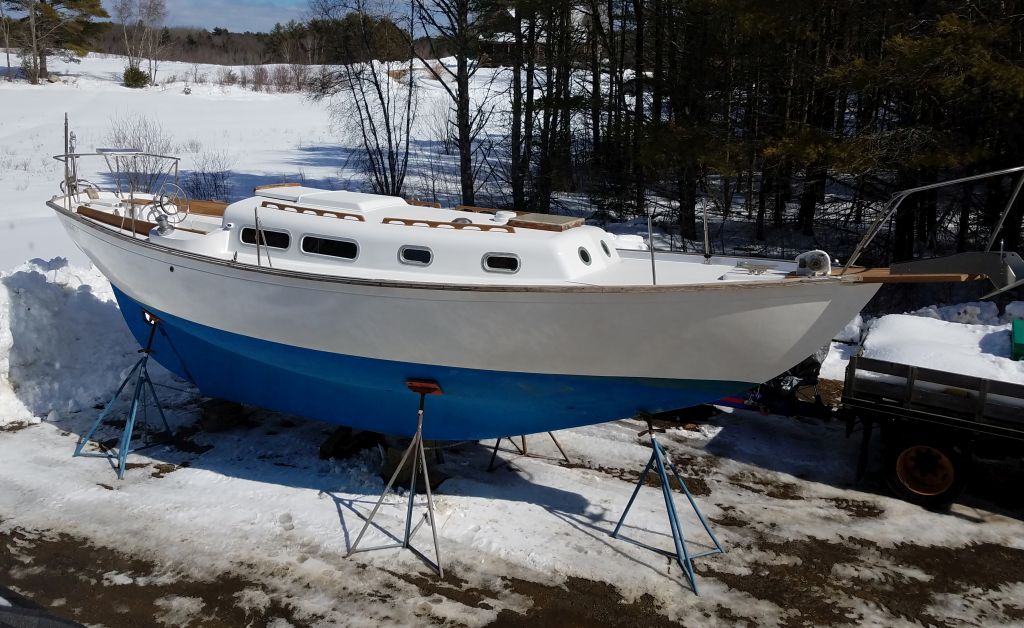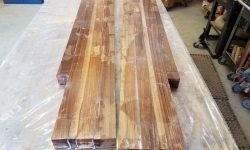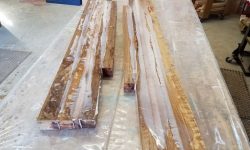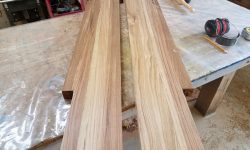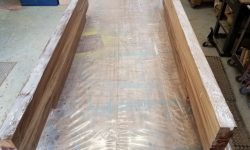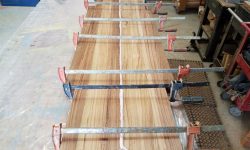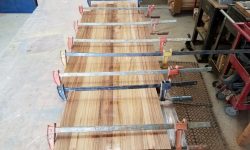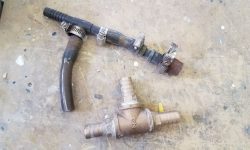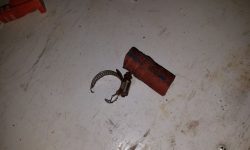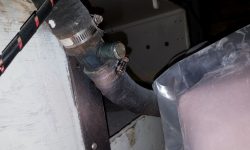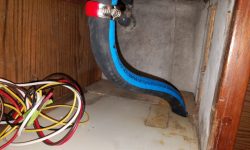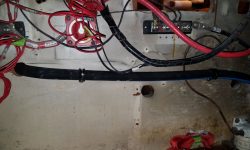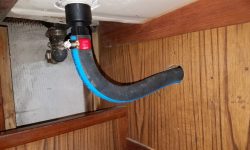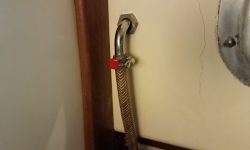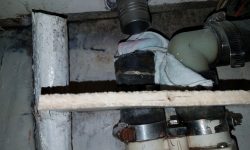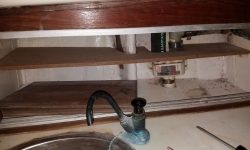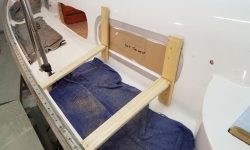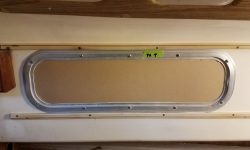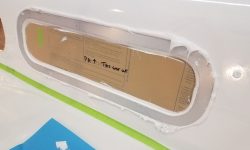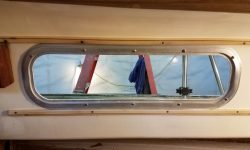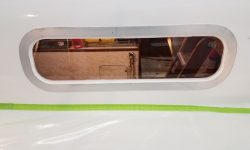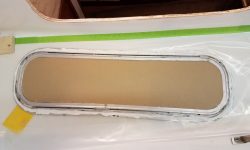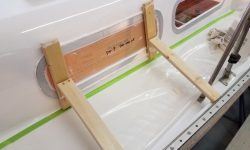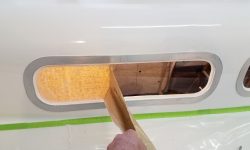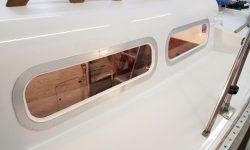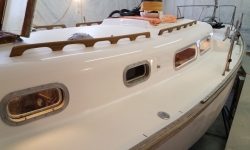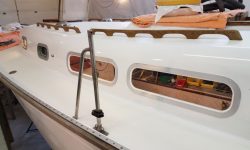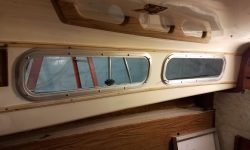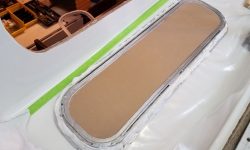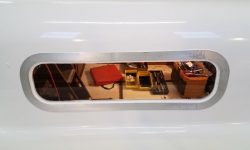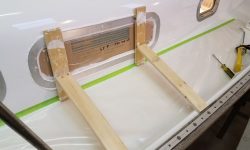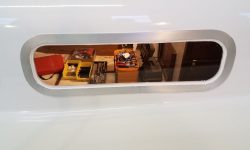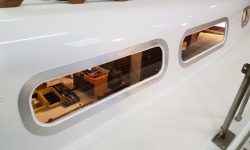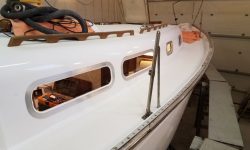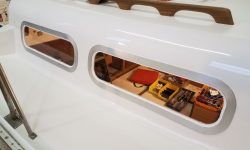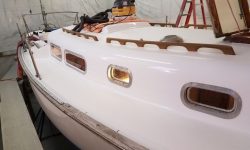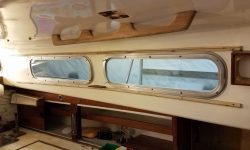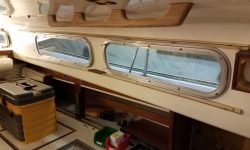February 23, 2018
Jasmine 58
Friday
I removed the clamps from the two sections of the new bow platform, then ran the pieces through the planer to remove the excess epoxy and bring the thickness of the blanks to the finished dimension.
After final preparations, I laminated the two sections together with thickened epoxy adhesive, clamping them securely and removing the excess epoxy from top of the joint.
Earlier, I’d removed the old drain hoses and mismatched plumbing fittings left over from the original cockpit seat drains, and now, with new 3/4″ hose and bronze replacement parts on hand, I prepared to finish up the drain lines to the new drain fittings I’d installed.
The drains had led into a tee fitting on the starboard cockpit scupper hose. There was a short section of older hose still attached to the tee, and although I briefly considered leaving it be, I just couldn’t. Of course the clamp was well rusted, so it took some effort to remove it by awkwardly cutting and eventually prying it loose, but it didn’t make sense not to replace the full length of hose.
Drilling larger access holes as needed, I led the new reinforced drain hose from the two deck fittings and down into the engine room along the route the originals had followed, and eventually connected everything with the new bronze tee fitting below the cockpit sole, completing the drains’ installation.
Sticking with plumbing for the moment, I took care of the reconnections in the head for the waste tank vent and deck pumpout fitting, as I’d had to remove these hoses earlier in the project. The vent was a cinch, but the short original section of waste hose leading from the Y-valve to the deck fitting was now too short to reach the new deck plate, which had a shorter barb length than whatever mess had been cobbled together before, so this meant I had to install a new, longer hose. This in turn required that I remove what remained of the little shelf (I’d already cut out half of it early in the job to gain access to the nearby chainplate), and with little finesse I busted out the remains so I could access and replace the hose, which was straightforward enough when all was said and done.
Afterwards, I made up a quick shelf replacement, using the pieces of the original as a guide, and installed it loosely for now, just in case I needed to remove it for the chainplate when I could finally reinstall it.
Standing in the cabin later, looking around and considering various aspects of the electrical system–and contemplating getting started on that–I found my attention drawn to the deadlight openings. I’d been thinking for a while that the deadlights’ design/installation details were such that, unlike in many cases, I could install them alone, and before I knew it I’d gone off in that direction, even though I’d originally had no intention of installing them today. But test-fitting one of the assembled outer frames, now ready for further work with all the sealant well cured, I found that, as I’d anticipated, it ought to be possible to install the frames permanently with only some simple bracing from outside, just to hold the frame as necessary while I installed the trim ring inside. Here, the tall bulwarks were my friend, as I found I could easily brace from there and hold the frame in place during a dry fit.
Anxious as always to continue knocking projects off the punch list, I went ahead and made preparations for the frames, cleaning up the area (beginning on the port side), covering the deck with plastic, and preparing tools, fasteners, and the trim rings. I thought I’d just take it one frame at a time, and if I ran into issues I’d stop and regroup.
Ready for the first installation, I gooped up the back side of the aluminum frame heavily with sealant, using way more than I knew was necessary since it always pays to have a ton in there in this sort of installation. I pressed the frame into position and braced it again to hold it. The fit was such that the bracing may not have been strictly necessary, though it certainly helped. Inside, pleasingly, it was surprisingly straightforward to install the trim ring, and all the screws–the originals, which I’d saved in their removal order throughout the process–drew in tightly and well, swelling me with confidence.
The frame had drawn up tightly all around, and after removing the bracing I cleaned up the abundant excess and removed the protective paper from both sides of the new lens.
That didn’t take long, and happy with how the project was going, I continued with the port forward frame, which was also happily uneventful.
I moved my operation over to the starboard side, and continued with the starboard after frame. Here, I ran into some more difficulty, as the nature of the interior liner in this particular spot was such that the outer frame actually protruded too far into the cabin in some places (the forward side) and not enough in others (the top center). So while I didn’t have any outward issue pressing the frame in from the outside, I found that the fasteners bottomed out before holding things tightly at the forward side, and others couldn’t even reach the frame as needed. At one point, thinking it was an issue with the outer frame, I added a longer brace to the shop wall to press in the trouble area, but this was before I understood the nature of the problem.
In the end, I prevailed, switching out the forward fasteners for some temporary (and longer) screws that I fitted with nuts on the inside, so that I could drive in the screw, then use the nut to press the trim ring in and pull the assembly together, a technique I’d used many times in the past. This would hold things till the sealant cured, and later I’d replace these temporary bolts with new, shorter screws that wouldn’t bottom out before holding things tightly, but I didn’t have these on hand.
Fortunately, this trouble was an anomaly, and the final deadlight installation went quickly and smoothly with no issues, bringing the day–and the week–to a successful close.
Total time billed on this job today: 6.5 hours
0600 Weather Observation: 16°, clear. Forecast for the day: Sunny, then increasing clouds and chance of minor snow/mixed precipitation late in the day. High around 35°.


